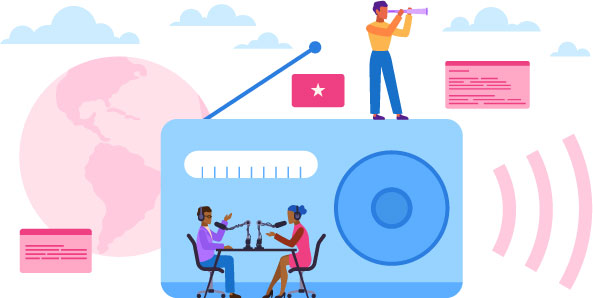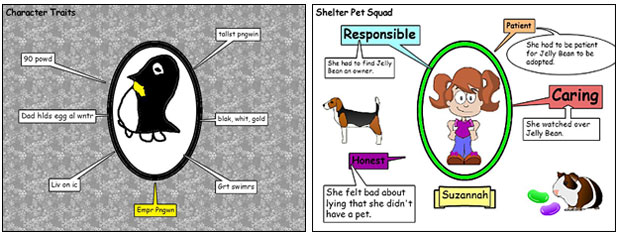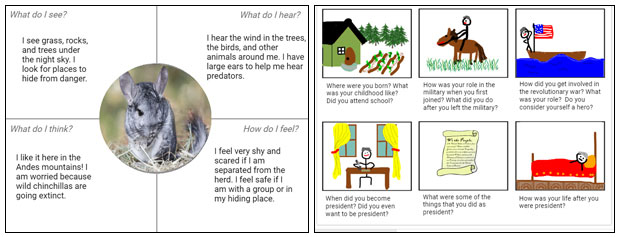
Build questioning, thinking, and communication skills as students share ideas and information in story form

Digital storytelling began as the sharing of a personal narrative using a combination of images, text, sound, and voice narration. Since its inception, digital storytelling has expanded to include a range of techniques and products.
Creating a digital story in the form of an interview helps you engage students in writing and makes work with informational text come alive. Students can interview real people through a traditional exchange of information via email or phone call, but students can also craft fictitious interviews to demonstrate comprehension of the traits and behaviors of characters in novels, animals, or figures from history.
“Students who are afforded a chance to demonstrate comprehension in a creative manner are far more likely to retain information than if they had been required to summarize, match, or recall.” -- Elizabeth Allen
Asking students to demonstrate understanding by crafting both the questions and answers of an interview helps you create a classroom culture that clearly demonstrates you the value and importance of great questions as much as great answers. With the volume of information available, it is essential for today’s students to know how to ask great questions to more effectively find information to inform themselves as well as apply it to impact the world around them.
We are probably most familiar with an interview that takes the form of a question-and-answer session between two people. Consider interviewing a family member, a career leader, a veteran, a refugee, a community helper, or unsung hero. This is a straightforward way to start and encourages listening, curiosity, and empathy skills.
While you may need to provide a template for students as they begin to develop their questioning skills, avoid furnishing them with the questions and ask students to develop the questions they should ask on their own. Of course, you will need to scaffold, but progress from providing questions, to working as a class to identify questions, to crafting questions individually. This will eventually provide students with the skills to listen to an interviewee and ask new or improved questions based on the stories they are hearing.
Explore the Everyday Heroes lesson plan
While an audio recording, or its transcript, can serve as the interview product, taking a digital storytelling approach allows you to bolster student thinking and communication skills. Encourage students to change the order of questions or the order of the answers shared so that the story “unfolds a lesson learned.” In other words, what is the moral of this person’s story or what does it have to teach the rest of us?
Introduce this type of interview at the beginning of the school year with a “getting-to-know-you” interview. Instead of students telling others about themselves, have them interview a classmate and prepare a digital story that introduces them to the rest of the students. The results of the interview might take the form of an oral presentation or a visual collage, but the process involves asking questions and retelling answers in your own words based on what you found interesting.
A different approach is to ask students to craft fictitious interviews with animals and objects they personify, book characters, and people from the past. Sharing factual information in story form helps students avoid simple repetition of facts or direct copy and paste. By crafting answers in first-person, students must rewrite facts and provide context and perspective for them, helping them develop a deeper understanding of their meaning and impact. Crafting interviews also builds critical thinking and communication skills as students arrange, prioritize, order, combine, plan, and dramatize.
Kids love animals, so use this love to build research, questioning, and communication skills. In second and third grade, students are likely to need guidance with both research and questioning.
Explore the Interview an Animal lesson plan
For students who would benefit from more of a challenge, consider asking them not to interview a single animal, but to instead personify and interview a plant or object in the animal's habitat. For example, instead of interviewing a Golden Lion Tamarin, interview a Goji berry, something the tamarin eats. This allows students to conduct an interview that shares information about the entire rainforest ecosystem and its interconnectedness.
Interviewing historical figures, or personified artifacts, is a great way to connect students to the past. They build empathy and better understand point of view as they tell the story of history from the perspective of a single person or object.
Explore the Interview an Artifact lesson plan
Choosing an artifact will retell history from the perspective of the author of the interview. Interviewing a single historical figure can help students understand how history is viewed from a range of perspectives, depending on the factors such as age, race, class, gender, and experience.
Interviewing a character from a book helps students identify less obvious character traits and better comprehend why a character acts and behaves the way they do.
Explore the Interview a Book Character lesson plan
An interview with a single character from a book is a great performance assessment for character comprehension. An interview between two different characters in a text requires even more comprehension of traits, behaviors, experiences, and perspectives.
The process of digital storytelling might vary by the words people use to describe it, but they all fall under the same general trajectory. Set expectations for their work by sharing examples of what high-quality interviews look like and then group students into teams. Have students begin by brainstorming what they know about the topic/subject and questions they think they would like to ask.
Support student thinking and metacognition during the process with graphic organizers. For example, as students begin brainstorming what they know about the topic/subject and questions they think they would like to ask, you can use a cluster organizer or character trait diagram to capture student thinking and help make their ideas visible for you and the entire team.

Clusters can help students identify both prior knowledge about the subject or topic. Cluster organizers can also provide a place to brainstorm questions students would like answered, and to answer, in the interview.

As students work to take on the perspective of the interviewee, employ an empathy map that asks what the character or subject sees, hears, thinks, and feels. This makes it easier for students to identify their perspective or point-of-view. It’s especially helpful if you are asking students to personify an animal, virus, or historical object. Have students use a storyboard to review both their questions and the answers for the interview to help identify and arrange the scenes to tell the most compelling story.
Today's digital tools make it easy to create and share a range of interview products. If you have a podcast, you can create a simple audio file to share on your web site. If your students have access to a digital creativity tool like Wixie, students have a range of interview product options such as:
Interviews can look very differently, so explore the tools and options you and your students have access to and decide accordingly.
When students first create an interview or digital story, you may want to narrow down the type of interview "product" to a single option, so that everyone is working the same way and you can more easily support their productions. As students progress in their digital storytelling and interview skills, give students a prompt or purpose and let them choose the interview product style that best communicates the story they want to share.
No matter what path you take in the classroom and what direction your students take their interviews, work to transfer responsibility to students for all facets of the process. When students direct and control their own learning, they build essential thinking, communication, collaboration, and project skills essential to life in the digital age.

Wixie
Share your ideas, imagination, and understanding through writing, art, voice, and video.

Rubric Maker
Create custom rubrics for your classroom.

Pics4Learning
A curated, copyright-friendly image library that is safe and free for education.

Wriddle
Write, record, and illustrate a sentence.

Get creative classroom ideas delivered straight to your inbox once a month.
Topics